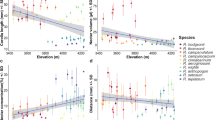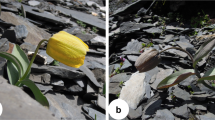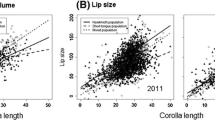Abstract
Large floral displays receive more pollinator visits but involve higher production and maintenance costs. This can result in indirect costs which may negatively affect functions like reproductive output. In this study, we explored the relationship between floral display and indirect costs in two pairs of coflowering sympatric Mediterranean Cistus of contrasting flower size. We hypothesized that: (1) corolla production entails direct costs in dry mass, N and P, (2) corollas entail significant indirect costs in terms of fruit set and seed production, (3) indirect costs increase with floral display, (4) indirect costs are greater in larger-flowered sympatric species, and (5) local climatic conditions influence indirect costs. We compared fruit set and seed production of petal-removed flowers and unmanipulated control flowers and evaluated the influence of mean flower number and mean flower size on relative fruit and seed gain of petal-removed and control flowers. Fruit set and seed production were significantly higher in petal-removed flowers in all the studied species. A positive relationship was found between relative fruit gain and mean individual flower size within species. In one pair of species, fruit gain was higher in the large-flowered species, as was the correlation between fruit gain and mean number of open flowers. In the other pair, the correlation between fruit gain and mean flower size was also higher in the large-flowered species. These results reveal that Mediterranean environments impose significant constraints on floral display, counteracting advantages of large flowers from the pollination point of view with increased indirect costs of such flowers.


Similar content being viewed by others
References
Aigner PA (2005) Variation in pollination performance gradients in a Dudleya species complex: can generalization promote floral divergence? Funct Ecol 19:681–689
Andersson S (1999) The cost of floral attractants in Achillea ptarmica (Asteraceae): evidence from a ray removal experiment. Plant Biol 1:569–572
Andersson S (2000) The costs of flowers of Nigella degenii inferred flower and perianth removal experiments. Int J Plant Sci 16:903–908
Andersson S (2001) Fitness consequences of floral variation in Senecio jacobaea (Asteraceae): evidence from a segregating hybrid populations and a resource manipulation experiment. Biol J Linn Soc 74:17–24
Andersson S (2005) Floral costs in Nigella sativa (Ranuncualceae): compensatory responses to perianth removal. Am J Bot 92:279–283
Aragón CF, Escudero A, Valladares F (2008) Stress-induced dynamic adjustments of reproduction differentially affect fitness components of a semi-arid plant. J Ecol 96:222–229
Arista M, Ortiz PL (2007) Differential gender selection on floral size: an experimental approach using Cistus salviifolius. J Ecol 95:973–982
Arrington JM, Kubitzki K (2003) Cistaceae. In: Kubitzki K, Bayer C, Stevens PF (eds) The families and genera of vascular plants, vol V. Springer, Berlin, pp 62–70
Ashman TL, Schoen DJ (1996) Floral longevity: fitness consequences and resource costs. In: Lloyd DG, Barrett SCH (eds) Floral biology: studies on floral evolution in animal-pollinated plants. Chapman and Hall, New York, pp 112–139
Ashman TL, Schoen DJ (1997) The cost of floral longevity in Clarkia tembloriensis. Evol Ecol 11:289–300
Bosch J (1992) Floral biology and pollinators of three co-occurring Cistus species (Cistaceae). Bot J Linn Soc 109:39–55
Caruso CM (2006) Plasticity of inflorescence traits in Lobellia siphilitica (Lobeliaceae) in response to soil water availability. Am J Bot 93:531–538
Castro S, Silveira P, Navarro L (2008) Effects on pollination on floral longevity and costs of delaying fertilization in the out-crossing Polygala vayredae Costa (Polygalaceae). Ann Bot 102:1043–1048
Chapin FS III (1989) The cost of tundra plant structures: evaluation of concepts and currencies. Am Nat 133:1–19
Conner JK, Rush S (1997) Measurements of selection on floral traits in black mustard, Brassica nigra. J Evol Biol 10:327–335
Cruden RW, Lyon DL (1985) Patterns of biomass allocation to male and female functions in plants with different mating system. Oecologia 66:299–306
Elle E, Hare JD (2002) Environmentally induced variation in floral traits affects the mating system in Datura wrightii. Funct Ecol 16:79–88
Fang X, Turner NC, Yan G et al (2010) Flower numbers, pod production, pollen viability, and pistil function are reduced and flower and pod abortion increased in chickpea (Cicer arietinum L) under terminal drought. J Exp Bot 61:335–345
Galen C (1989) Measuring pollinator-mediated selection on morphometric floral traits: bumblebees and the alpine sky pilot, Polemonium viscosum. Evolution 43:882–890
Galen C (1999) Why do flowers vary? The functional ecology of variation in flower size and form within natural plant populations. Bioscience 49:631–640
Galen C (2000) High and dry: drought stress, sex-allocation trade-offs, and selection on flower size in the alpine wildflower Polemonium viscosum (Polemoniaceae). Am Nat 156:72–83
Galen C (2005) It never rains but then it pours: the diverse effects of water on flower integrity and function. In: Reekie E, Bazzaz FA (eds) Reproductive allocation in plants. Elsevier, San Diego, pp 77–95
Galen C, Sherry RA, Carroll AB (1999) Are flowers physiological sinks or faucets? Costs and correlates of water use by flowers of Polemonium viscosum. Oecologia 118:461–470
Halpern SL, Adler LS, Wink M (2010) Leaf herbivory and drought stress affect floral attractive and defensive traits in Nicotiana quadrivalvis. Oecologia 163:961–971
Harder LD, Johnson SD (2005) Adaptive plasticity of floral display size in animal-pollinated plants. Proc R Soc Lond B 272:2651–2657
Herrera J (1992) Flower variation and breeding systems in the Cistaceae. Plant Syst Evol 179:245–255
Herrera C (1993) Selection on floral morphology and environmental determinants of fecundity in a hawk moth-pollinated violet. Ecol Monogr 63:251–275
Hodgins KA, Barrett SCH (2008) Natural selection on floral traits through male and female function in wild populations of the heterostylous daffodil Narcissus triandrus. Evolution 62:1751–1763
Jones KN (2001) Pollinator-mediated assortative mating: causes and consequences. In: Chittka L, Thompson JD (eds) Cognitive ecology of pollination: animal behaviour and floral evolution. Cambridge University Press, Cambridge, pp 259–273
Konsens I, Ofir M, Kigel J (1991) The effect of temperature on the production and abscission of flowers and pods in snap bean (Phaseolus vulgaris L.). Ann Bot 67:391–399
Kudoh H, Wigham DF (1998) The effect of petal size manipulation on pollinator/seed-predator mediated female reproductive success of Hibiscus moscheutos. Oecologia 117:70–79
Larcher W (2000) Temperature stress and survival ability of Mediterranean sclerophyllous plants. Plant Bios 134:279–295
Littell RC, Milliken GA, Stroup WW, Wolfinger RD (1996) SAS system for mixed models. SAS Institute, New York
Méndez M, Traveset A (2003) Sexual allocation in single-flowered hermaphroditic individuals in relation to plant and flower size. Oecologia 137:69–75
Montalvo AM, Ackerman JD (1987) Limitations to fruit production in Ionopsis utricularioides (Orchidaceae). Biotropica 19:24–31
Muñoz-Garmendía F, Navarro C (1993) Cistaceae. In: Castroviejo S, Aedo C, Gómez-Campo M et al (eds) Flora Iberica. CSIC, Madrid, pp 318–436
Nattero J, Cocucci A, Medel R (2010) Pollinator-mediated selection in a specialized pollination system: matches and mismatches across populations. J Evol Biol 23:1957–1968
Ninyerola M, Pons X, Roure JM (2005) Atlas climático digital de la Península Ibérica. Metodología y aplicaciones en bioclimatología y geobotánica. Universidad Autónoma de Barcelona, Barcelona, ISBN 932860-8-7. http://opengis.uab.es/wms/iberia/. Accessed 15 Sept 2011
Parra-Tabla V, Bullock SH (2000) Phenotypic natural selection on flower biomass allocation in the tropical tree Ipomoea wolcottiana Rose (Convolvulaceae). Plant Syst Evol 221:167–177
Pyke GH (1991) What does it cost a plant to produce floral nectar? Nature 350:58–59
Quinn G, Keough M (2002) Experimental design and data analysis for biologists. Cambridge University Press, Cambridge
R Development Core Team 2010 R: A language and environment for statistical computing. R Foundation for Statistical Computing, Vienna, Austria, ISBN 3-900051-07-0. http://www.R-project.org
Stanton ML, Snow AA, Handel SN (1986) Floral evolution: attractiveness to pollinators increases male fitness. Science 232:1625–1627
Thompson JD (2001) How do visitation patterns vary among pollinators in relation to floral display and floral design in a generalist pollination system? Oecologia 126:386–394
Thompson JD (2005) Plant evolution in the Mediterranean. Oxford University Press, New York
Vemmos SN, Goldwin GK (1994) The photosynthetic activity of Cox’s orange pippin apple flowers in relation to fruit setting. Ann Bot 73:385–391
Vespirini JL, Pacini E (2010) Pollination ecology in sympatric winter flowering Helleborus (Ranunculaceae). Flora 205:627–632
Young HJ, Stanton ML (1990) Influences of floral variation on pollen removal and seed production in wild radish. Ecology 71:536–554
Acknowledgments
A. Traveset and J. M. Iriondo provided constructive comments during earlier versions of the manuscript. We also thank to R. Aceves, E. Barahona, F. Castellanos, C. de Castro, J. Iglesias and H. Lantarón for fieldwork support. We are also grateful to Y. Valiñani and E. Galisteo for lab assistance and Lori J. De Hond for linguistic assistance. This study was supported by CONSOLIDER MONTES project (CSD2008-00040) of the Spanish Ministerio de Ciencia e Innovación. A.L.T. held a PDI fellowship at Rey Juan Carlos University, Spain. The experiments comply with the current laws of Spain.
Author information
Authors and Affiliations
Corresponding author
Additional information
Communicated by Christina Caruso.
Rights and permissions
About this article
Cite this article
Teixido, A.L., Valladares, F. Large and abundant flowers increase indirect costs of corollas: a study of coflowering sympatric Mediterranean species of contrasting flower size. Oecologia 173, 73–81 (2013). https://doi.org/10.1007/s00442-013-2609-8
Received:
Accepted:
Published:
Issue Date:
DOI: https://doi.org/10.1007/s00442-013-2609-8




